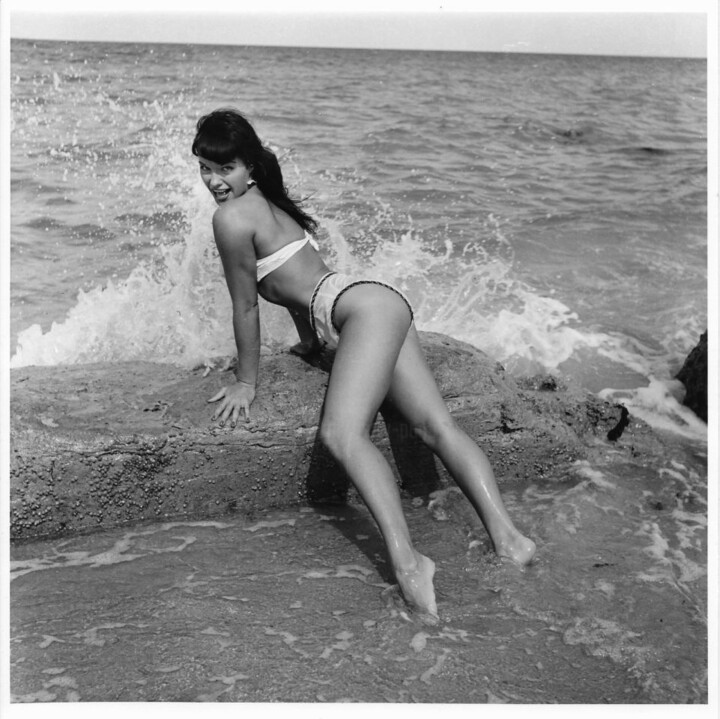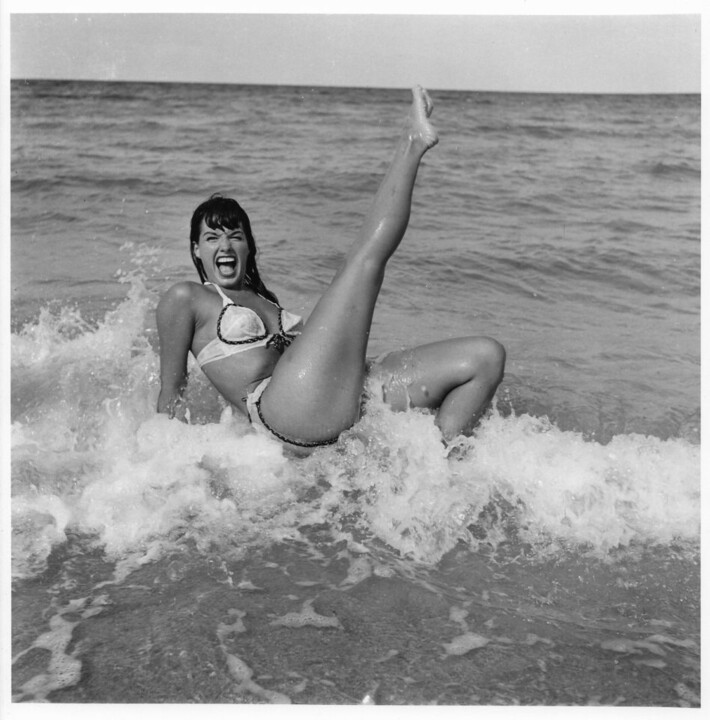Linnea Eleanor Yeager, better known as Bunny Yeager, was a trailblazing American photographer and iconic pin-up model whose career spanned several decades and left a lasting impact on both fields. Born on March 13, 1929, in Wilkinsburg, Pennsylvania, Yeager’s unique blend of modeling and photography redefined the pin-up genre and contributed significantly to its popularity. After starting her career as a model, she transitioned to photography, where she became renowned for her innovative and influential work. Despite facing personal challenges, including the loss of two husbands and her own passing on May 25, 2014, in North Miami, Florida, Bunny Yeager's legacy endures through her pioneering contributions to art and culture.
Artist Biography: Bunny Yeager
Bunny Yeager, born Linnea Eleanor Yeager on March 13, 1929, in Wilkinsburg, Pennsylvania, was a transformative figure in American modeling and photography whose innovative work reshaped the pin-up genre. Growing up in a dynamic environment, Yeager moved to Florida at 17, where she adopted the nickname "Bunny," inspired either by Lana Turner's character in the film Week-End at the Waldorf or by her role as the Easter Bunny in a high school play. She graduated from Miami Edison High School and pursued modeling at the Coronet Modeling School and Agency. Her striking looks and charisma led to a series of beauty pageant wins, including titles such as Queen of Miami and Miss Trailercoach of Dade County, establishing her as a prominent model in Miami.
Yeager's career took a significant turn in the 1950s when she began to blend her modeling with photography. Driven by a desire to save money on modeling fees, she enrolled in a night photography class in 1953. Her foray into professional photography quickly bore fruit; her debut assignment, a photo of Maria Stinger, graced the cover of Eye magazine in March 1954. Yeager became known for her technical prowess and creativity, pioneering the use of fill flash to mitigate harsh shadows and embracing outdoor natural light for her shoots. Her vibrant and dynamic images, characterized by active poses and direct gazes, captured both playful innocence and a bold allure. Yeager's collaboration with Bettie Page in 1954 marked a high point in her career. Over the course of their brief but prolific partnership, Yeager photographed Page in over 1,000 images, significantly contributing to Page's iconic status. Their work, especially the famous January 1955 Playboy centerfold and a series with live cheetahs, became defining examples of 1950s erotica. This collaboration, along with her efforts alongside photographer Irving Klaw, cemented Yeager's place in the annals of pin-up history, with American Photo magazine hailing her work as some of the most memorable and enduring erotica on record.
Throughout the 1950s and 1960s, Yeager's work appeared extensively in men's magazines, including Playboy, where she shot eight centerfolds and numerous covers. She also discovered and worked with notable models such as Lisa Winters, the first Playmate of the Year. Her influence extended beyond men's magazines to mainstream publications like Cosmopolitan, Esquire, and Redbook, with her most famous work including the iconic bikini photos of Ursula Andress for the James Bond film Dr. No. As the industry evolved and men's magazines became more explicit in the 1970s, Yeager stepped back from this realm, criticizing the shift towards more graphic content.
In the later years of her career, Yeager's work was celebrated through numerous exhibitions and retrospectives. The 1990s saw shows like "Beach Babes Bash" and "Sex Sirens of the Sixties" at the Center for Visual Communication, and in 2010, The Andy Warhol Museum held the first major museum exhibition of her work, "The Legendary Queen of the Pin Up." Subsequent exhibitions, including "The Fabulous Bunny Yeager" and "Bunny Yeager: Retrospective to the Future," continued to highlight her significant contributions to photography. Internationally, her work was showcased in Germany and Bulgaria, with the Museum of Art Fort Lauderdale hosting a major retrospective in 2013. Yeager's influence and legacy persist through her innovative techniques, pioneering spirit, and the lasting impact of her images on both fashion and photography. She maintained a studio in Miami’s Wynwood Art District and was also a founding editor of Florida Stage & Screen, a trade magazine for entertainment professionals. By the time of her passing on May 25, 2014, in North Miami, Florida, Yeager had left an indelible mark on the art world, with her photographs and designs continuing to be celebrated and studied.
Brief History of American Photography
The practice of photography in the United States began in the 19th century with the introduction of the daguerreotype, a French-developed process brought to America by D.W. Seager in 1839, which quickly captivated influential figures like Samuel Morse. Despite its lengthy exposure times and occasional unflattering results, the daguerreotype’s detailed reproductions made it popular. By the 1860s, advancements such as the collodion wet-plate process allowed for replicable negatives, leading to extensive war documentation by photographers like Mathew Brady during the Civil War. The late 19th century saw George Eastman's revolutionary Kodak camera and flexible film, which democratized photography and made it accessible to the masses. Key 19th-century photographers, including Brady, Eadweard Muybridge, and Alfred Stieglitz, significantly contributed to the field, shaping modern photography and its role in American culture.
Floride - 1995 #2 (1955) by Bunny Yeager,
Bunny Yeager, Floride - 1995 #2, 1955. Photography, Non Manipulated Photography / Analog photography on Paper, 19.5cm x 18cm.
Floride - 1995 #2 is a captivating black-and-white photograph by the renowned photographer Bunny Yeager, showcasing her distinctive style and her collaboration with the iconic pin-up model Betty Page. Taken in 1955, this photograph is part of an exclusive series that captures a moment of timeless elegance and camaraderie between the two women. The image depicts Page posing gracefully on a Miami beach, dressed in a stylish bikini complemented by tights and heels, embodying the vibrant fashion and allure of the era. The photograph, produced using analog photography techniques, remains non-manipulated, preserving the authentic essence of the moment. It reflects Yeager's keen eye for composition and her ability to capture the dynamic energy and playful spirit of her subjects. The photograph is notable for its engaging portrayal of Page, who appears with a mix of flirtatious charm and innocent allure, contributing to the overall captivating presence of the image. The setting—a sunlit Miami beach—adds a warm, nostalgic backdrop to the composition, enhancing the photograph's evocative quality. This particular image is part of a unique series shot at both the beach and the Africa Park in Miami, underscoring the close personal and professional relationship between Yeager and Page. The series, which includes several unpublished and unretouched photographs, reflects the genuine friendship and mutual admiration shared by the two women. The photograph is a posthumous print made under Yeager's direction, ensuring its fidelity to the original work. It comes from the collection of Pierre Lescure, acquired in the 1990s, and remains a testament to the enduring impact of Yeager's work and her contributions to mid-20th-century photography.
Betty Page Studio Costume Noir #16 (1955) by Bunny Yeager
Bunny Yeager, Betty Page Studio Costume Noir #16, 1955. Photography, Non Manipulated Photography / Analog photography on Paper, 19.5cm x 19.5cm.
Betty Page Studio Costume Noir #16 (1955) is a striking black-and-white photograph by Bunny Yeager that exemplifies the collaboration and friendship between Yeager and the iconic pin-up model Betty Page. Taken in 1955, this photograph is part of a unique studio series shot in Miami, showcasing Page in an exquisite self-designed costume. The photograph captures Page in a dramatic and stylish pose, wearing a meticulously crafted black outfit that she designed herself for this shoot. The choice of costume, combined with Page’s confident and expressive demeanor, highlights the creative synergy between the model and photographer. The use of analog photography ensures that the image remains unmanipulated, maintaining the authentic quality of the original shot. Yeager’s skillful use of lighting and composition in this photograph enhances the dramatic effect of Page’s outfit, adding depth and texture to the overall image. Page’s expression, a mix of playful allure and subtle defiance, conveys the dynamic energy that characterized their professional relationship and the era's aesthetic.
Iconic Works
Bunny Yeager's body of work includes a diverse range of photographic collections and publications, showcasing her expertise in pin-up and glamour photography. Her notable series include Pin Up Girls of the 1960s, Bikini Girls of the 1950s, and Beautiful Backsides, alongside thematic collections like Striptease Artists of the 1950s and Femmes Fatales of the 1950s. Yeager also explored the iconic figures of her time with works such as The Real Bettie Page: The Truth about the Queen of the Pinups and Betty Page Confidential: Featuring Never-Before Seen Photographs. Her contributions to glamour photography are further highlighted in publications like Art of Glamour Photography and Flirts of the Fifties. Additionally, her instructional book How To Take Figure Photos and other works like The Bigger Book of Breasts and Peep Show: Pin-Ups in 3-D reflect her influence and innovation in the field.
Bunny Yeager, who passed away on May 25, 2014, at the age of 85, was a highly influential photographer renowned for her work with pin-up models like Bettie Page and Ursula Andress. She was married twice and had two daughters. Yeager's pioneering photographic techniques and her role in popularizing the bikini and the term "cheesecake" left a lasting impact on erotic and fashion photography. Her work is credited with elevating pin-up photography to high art, influencing artists like Diane Arbus and Cindy Sherman, and her books, including Photographing the Female Figure, have sold over 300,000 copies, further cementing her legacy.




 Selena Mattei
Selena Mattei












